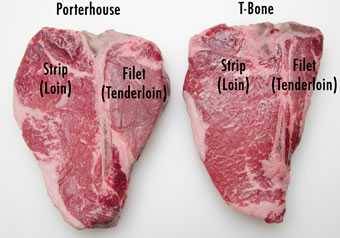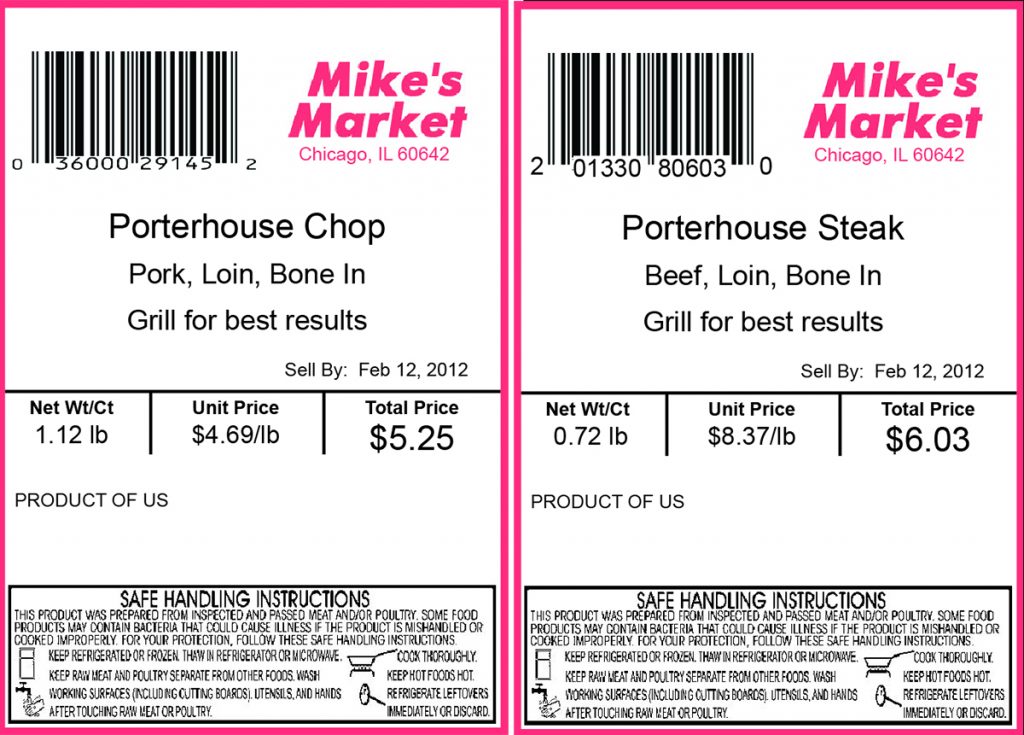Meat names are confusing, to say the least, so the announcement on April 4, 2013 that The Beef Checkoff Program, the National Pork Board, and the United States Department of Agriculture (USDA) have agreed to new labeling standards in an attempt to “make things easier on the consumer” should elicit unbridled joy from a man known as Meathead. What has really happened is these three promoters, and yes, a major part of the USDA’s mission is to promote US agriculture, have tweaked meat labels a bit and in the process found a way to “add value to the carcass”, and sell it as consumerism.
And in the process they have made all your cookbooks obsolete.
On the surface they are attempting to make meat labels less confusing, and if they follow up the new labeling nomenclature with the major marketing campaign they promise, they might make buying meat a teensy bit easier, but they are a long way from making it as easy as it could be, and a lot closer to jacking up prices just in time for barbecue season. But these guys are good, and practically every news report on the topic glowed with words like “user friendly” and touted the supposed consumer benefits.
The agreement, under the supervision of the Uniform Retail Meat Identity Standards (URMIS), being implemented as we eat, attaches to meat cuts some of the more marketable names used by restaurants rather than the anatomical and technical names used by butchers. Lamb, bison, and veal names will remain the same for awhile, but they will probably have to take a seat at the table eventually.
Kiss my pork butt and pork chops goodbye

The most significant changes impact pork, specifically its loin muscle. That’s the long lean muscle that runs along either side of the spine from shoulder to hip. You have a pair of them on either side of your spine, too. This is the most valuable muscle on the animal and the one for which the expression “eating high on the hog” was created.
Pork chops from the loin will begin using more sexy names previously seen only on beef. Chops from the rib section of the loin, previously called “pork loin chops” or “rib chops”, will be called “ribeyes (at right)”, same as beef steaks from the same location. Pork chops from further back will be called “strip chops” same as “strip steaks”. Chops from further back still will be called “T-bone chops”, and at the end of the chain, “porterhouse chops”. All four of these cuts were often called simply “pork chops”, and, although they are different, the taste and texture differences are minor. That’s one step forward for equality between species, one step forward for culinary accuracy, and two steps backward at the cash register.

How this is easier is hard to understand? Few except the most ravenous carnivores can explain the difference between a “porterhouse steak” and a “T-bone steak”. Final answer: The T-bone and porterhouse are similar looking steaks with two muscles separated by a T-shaped bone. One side of the T has a large section of loin and the other has a small section of tenderloin, which is a different, more tender muscle. The difference between the porterhouse and T-bone is the size of tenderloin. Because the tenderloin tapers like a baseball bat and the T-bone is further to the front of the animal, the tenderloin portion is smaller than on the porterhouse, a minimum of 1/2″ wide at the T. The tenderloin on the porterhouse must be a minimum of 1 1/4″ wide, but they can be up to 3″ wide. Because pork chops are smaller than beef steaks, who knows how this will translate. My friend John Dawson of PatioDaddioBBQ.com says they ought to call it “porkerhouse”.
Under the new system, “pork butt” or “Boston butt”, which is a cut from the hog’s shoulder, not the rear end as you might think, will now be called the “Boston roast”. Butt, a commonly used name that appears in the North American Meat Processor’s Guide (NAMP), was previously called “Shoulder Blade Boston Roast” by URMIS will now be labeled “Boston roast”. That certainly gets rid of one of the goofiest anomalies in meat labeldom, calling a shoulder a butt, but just how is “Boston roast” more helpful? “Shoulder” would have been a lot more descriptive. Instead they went from confusing to meaningless.
There is a “new” pork cut called “loin riblets”. These are tiny nibs of cartilage on the spine called feather bones, a cut popularized as Applebee’s Famous Riblets. Watch for them in a store near you. Anything previously labeled “rump” has now become “leg”. And how the heck did the beef people let the pork people get away with calling part of the shoulder “brisket” when this popular beef cut is from the chest?
You got a beef with this?
Some beef names will also be changing. “Beef chuck eye country-style ribs boneless”, which sounds like something off a WWII C rations can, will become “country-style ribs”, a cut that is extremely popular on pork. Of course this is still not quite right since most “country-style ribs” have no ribs. Most have shoulder blade bones, and they really are closer to chops than ribs in both the way they taste and the way they should be cooked. In fact, cooking “country-style ribs” like one should cook “spareribs” will produce meat that will taste inferior to the plate upon which they are served. Alas, the new nomenclature simply did not go far enough to clean up these antiquated anomalies. “Country-style ribs” should be called “shoulder chops” on both animals.
Several cuts that used to be called “pot roast” have lost the word “pot”, perhaps because pot roast meat is considered a cheap cut. Or maybe they were afraid that it wpould attract drug addicts. Boring old “ball tip” has become “petite sirloin”. “Flap meat” has become “bavette”. Part of the “bottom round” is now elegantly named “merlot steak”. There are a whole lot of little cuts that will be labeled “strips”. Don’t be surprised if you find them in the meat case next to the more expensive “strip steaks”.
Surprisingly there is no “filet mignon” on the new list. This highly desirable cut is to be called “tenderloin filet”, not to be confused with “strip filet” or “top sirloin filet” or “ribeye filet” which are entirely different muscles. Clear on that? Among other popular names not on the list is “chateaubriand”, the pricey center cut from the tenderloin. Were “mignon” and “chateaubriand” too Frenchy for the focus groups? But “kebabs”, a Middle Eastern name, can now be used on cubes of both beef and pork.
“Beef shoulder boneless top blade steak” will now be called “flat iron steak” a common name for a tasty muscle that was relatively unknown until about a decade ago when meat scientists found a way to excavate it from the tangle of muscles in the shoulder and save it from the ignominy of pot roast or hamburger. It has since found a comfy home on restaurant menus and in the meat case at a “value added” price.
But just how is “flat iron” more descriptive than what it could be, “boneless shoulder blade steak”, which, although not memorable, tells you exactly what you are getting? Is “Denver roast” really more helpful than “beef chuck eye”? How is a city name more helpful that the name of the part of the animal? And what if you hate Peyton Manning? Will you really want a Denver roast?
And how will all this play with the new USDA labeling rules scheduled to take effect soon requiring labels to show where the animal was born, raised, and slaughtered. This is a valuable step towards transparency and will be immensely helpful if there is a food-borne illness outbreak. But how is Harvey the Househusband to interpret a Des Moines roast from Shanghai? How will Canada and Mexico respond to a law they believe is really protectionism designed to give US grown meats a market advantage?
New label designs
Although these new labeling standards approved for the Uniform Retail Meat Identity Standards (URMIS) are voluntary, I expect that most retailers will adapt them rapidly, as soon as they can reprogram the label printers on their scales, just in time for barbecue season. The new labels will feature three lines on the label:
LINE 1, in large type, will be the new name. Notice that pork or beef will not be on the top line.
LINE 2, in slightly smaller type, will display the species first, followed by some of the anatomical name of the cut.
LINE 3 will offer preparation suggestions.
So here’s the image at the top of this page shows how two cuts will look on the label. Notice that appropriate beef cuts will still be called steaks, and corresponding pork cuts will be called chops. But nothing can be that simple in the meat world, numerous pork cuts previously called steaks have been grandfathered in.
In the press releases it is claimed that 350 names will change. A close look at the 197 beef changes and the 121 pork changes (my fingers and toes show that to be 318 not 350) shows that most of them are minor and barely noticeable. “Beef round roast bone in” is now “round roast” on line 1, and “beef, bone in” on line 2. Not much of a difference there. In fact most of the changes are merely parsing the name into two lines. I count no more than a dozen or so significant changes.
And the winner is…
Yes, we consumers got a slightly easier to read label, but it looks to me that the pork people are the big winners here, relegating the species name to the second line while the new sexier value added beefy name goes up top. No longer are they trying to promote themselves as the “other white meat” and compete with chicken. They dropped that campaign last year. Now they are running with the bulls. Let’s not forget that in 2011 the pork people got USDA to lower the minimum recommended internal temp for whole muscle pork from 165°F to 145°F, while beef has been stuck at 145°F forever. Medium rare is about 130°F and if steakhouses all cooked their steaks to 145°F, at which temp they are barely still pink, they would go out of business in a week. If I’m ever caught “hiking the Appalachian Trail”, I’m hiring the pork lawyers, lobbyists, and PR flacks.
How we got here
The history of meat labeling is long and winding. For centuries, animals were slaughtered and broken down by the town butcher and by restaurants close to where they were grown, and there was no label consistency from one butcher to the next. This all changed in War World II when the government standardized on large “primal cuts” and corresponding nomenclature for some smaller cuts. URMIS was founded in 1973 but the anatomical jargon remained confusing and the new standards don’t do enough to really make things user friendly. To this day, nobody can say for sure what a “Delmonico steak” or a “London broil” really are, and they are not covered in the new guidelines. These marketing wizards need to ask, “WWJD? What would Jobs do?”
To add to the confusion, the cuts and names are different around the world, even in English speaking countries. Today The North American Meat Processors Meat Buyer’s Guide book has become the standard by which butchers cut their meats so a chuck roll is the same coast to coast. Clearly the next edition will be a big seller.
But the best news is that prudish lawmakers have not yet banned names like chicken breasts.



High quality websites are expensive to run. If you help us, we’ll pay you back bigtime with an ad-free experience and a lot of freebies!
Millions come to AmazingRibs.com every month for high quality tested recipes, tips on technique, science, mythbusting, product reviews, and inspiration. But it is expensive to run a website with more than 2,000 pages and we don’t have a big corporate partner to subsidize us.
Our most important source of sustenance is people who join our Pitmaster Club. But please don’t think of it as a donation. Members get MANY great benefits. We block all third-party ads, we give members free ebooks, magazines, interviews, webinars, more recipes, a monthly sweepstakes with prizes worth up to $2,000, discounts on products, and best of all a community of like-minded cooks free of flame wars. Click below to see all the benefits, take a free 30 day trial, and help keep this site alive.
Post comments and questions below
1) Please try the search box at the top of every page before you ask for help.
2) Try to post your question to the appropriate page.
3) Tell us everything we need to know to help such as the type of cooker and thermometer. Dial thermometers are often off by as much as 50°F so if you are not using a good digital thermometer we probably can’t help you with time and temp questions. Please read this article about thermometers.
4) If you are a member of the Pitmaster Club, your comments login is probably different.
5) Posts with links in them may not appear immediately.
Moderators